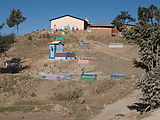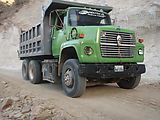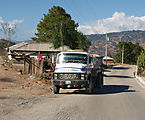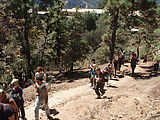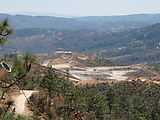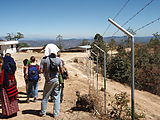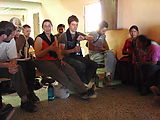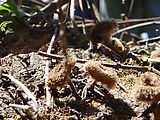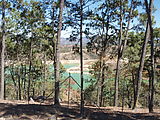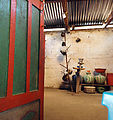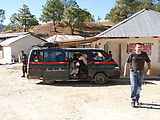San Miguel Ixtahuacán
Our final field trip organized by PLQE was to the remote village of San Miguel
Ixtahuacán, which has for the past few years been suffering from the consequences
of a strip-mining operation started next door. The presence of Montana, a
subsidiary of the Canadian Goldcorp
corporation, has brought a few jobs to the area, but has caused many
uncompensated problems with the health and livelihood of the local communities. 
 15.2427, -91.7313
15.2427, -91.7313
To help us gain a better understanding of this issue, we traveled with 18 other PLQE students in two rented microbuses to San Miguel Ixtahuacán.
Our 5-hour ride from Xela began before sunrise. We saw many things as we drove west through the Guatemalan countryside. We learned that cemeteries in Guatemala are always colorful! And, yes, there is a man under that huge load of dried corn plants.
Not only are chicken buses decorated — but trucks, too. One just cannot have too many Mercedes symbols on the front of a vehicle!
Somewhere on the way, our convoy of two microbuses acquired an unexpected police escort "for our protection". Every few hours, our escorting police vehicle would switch off with other officers waiting along the road. One tailgating police truck drove for an hour directly inside the cloud of smoke that was always behind our stinky diesel microbus.
We never really quite understood exactly what was the intention of this police escort. It was unclear whether this was an attempt at intimidation or honest protection, but it was easy to be suspicious when the government sides with the mining company rather than the people of the village we were visiting.
There is a group of women in San Miguel Ixtahuacán town who have come forward to speak out about what is happening to their town and its people. A few of the women showed us their houses and told their stories about how things have changed with the arrival of the mining company. When we arrived at San Miguel Ixtahuacán, we first toured the damage to the adobe houses — huge cracks that the townspeople have attributed to the daily explosions from the mine, and also to the large trucks driving by on the local dirt road. The homeowners' argument was that these houses had been around for over a century with no cracking, so why would they crack so quickly and significantly just now?
However, like many other stories that were told throughout the day, it was somewhat difficult to determine exactly what was happening here. We had two students from the school translating everything for us. They did an absolutely amazing job, but there was still so much left unanswered and unsaid. For example, even when we asked about the measurements posted on the walls, it was never very clear to us who measured the cracks, why they were measured, and what was concluded about them. We gathered more questions than answers.
We then walked to another part of town (through a once fenced-off corner of the land taken by the Montana mining company), where we met in a church to discuss the problems with some townspeople. The walk provided some good views of the strip-mining operation.
We walked through some fields to the site of a spring that the townspeople believe had dried up because of the nearby mining activities.
Lunchtime — we were met by some local hungry cats & kittens who were difficult to keep out of our food. I didn't know cats ate avocado!
Finally, we drove to another part of town where we were supposed to witness the skin problems of local children, but instead (due to some kind of miscommunication) we heard the story of an old gentleman dying of cancer. He also had some skin issues. Again, more questions: Were this man's problems really related to the mine? It was unclear.
As we traveled to and from his house, we had some good views of an unnaturally blue-green lake of water dammed on the mining site.
In the end, we left for our 5-hour trip back home to Xela with more questions than answers. Without any concluding discussions or a question and answer session, we left only with our minds full of the stories shared by these local people. Their lives do seem to have been changed drastically by the mining operation, but it's not quite clear who or what is directly to blame, or what we can do about it — other than share what we heard and saw. Here's a website that seems to describe this situation more clearly — and gives some ways to help these people.
Our trip home started with some misadventures when the microbuses didn't have sufficient traction to drive back up the steep dirt roads. Some of us had to get out and push, or temporarily ride in the truck bed of our police escort.

